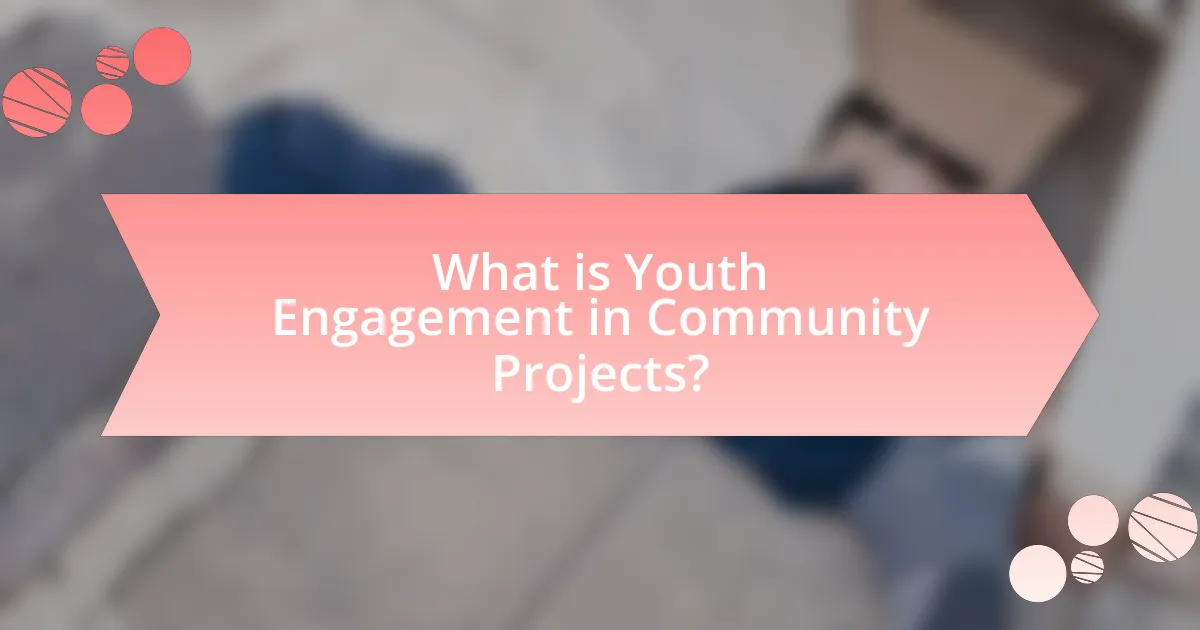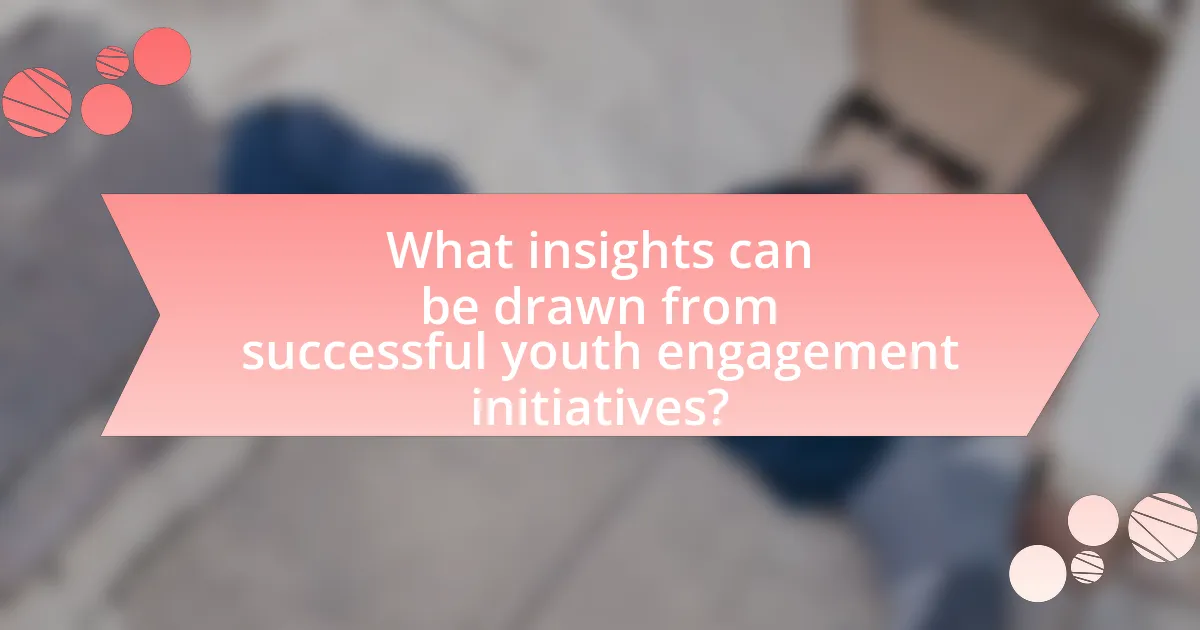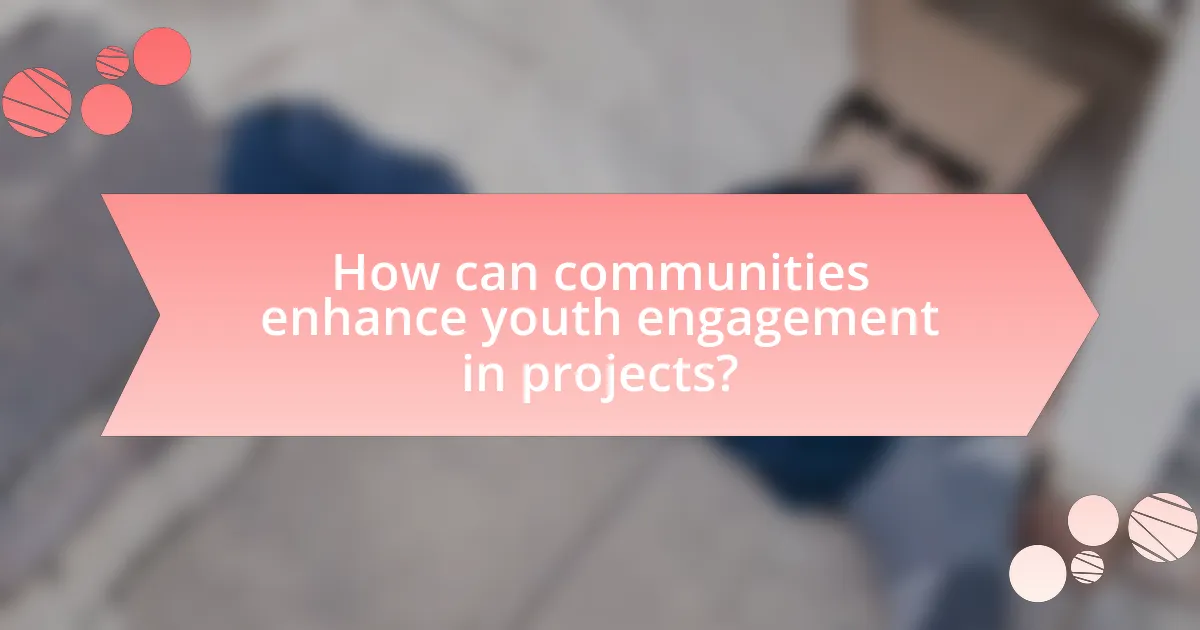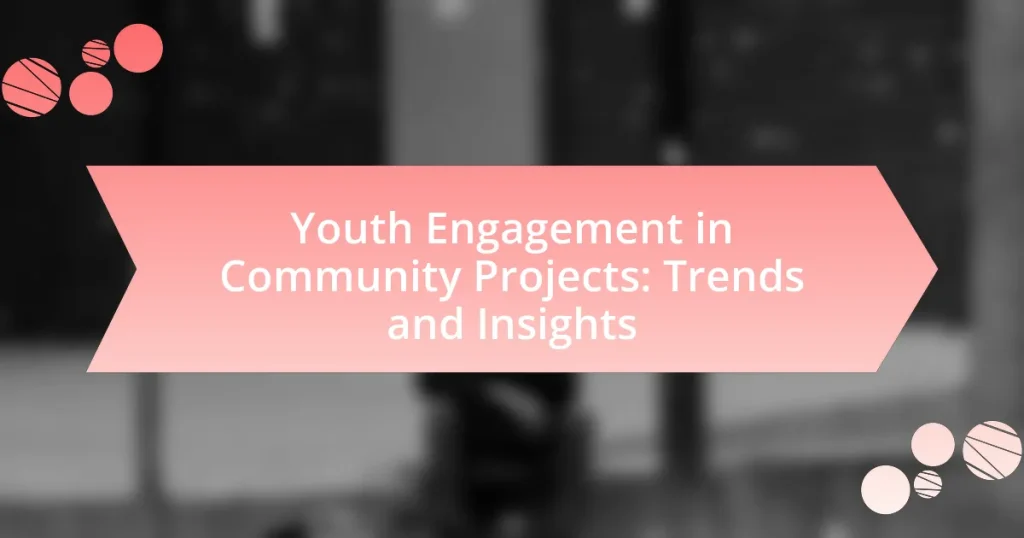Youth engagement in community projects refers to the active participation of young individuals in initiatives aimed at improving their communities through volunteering, leadership roles, and collaborative decision-making. This article explores the definition, importance, and characteristics of effective youth engagement, highlighting current trends such as the use of digital platforms and a focus on social justice. It also addresses the challenges youth face, including socioeconomic barriers and lack of support, while providing insights into successful engagement strategies and measurable outcomes. The article emphasizes the role of mentorship, partnerships, and inclusive practices in enhancing youth participation in community initiatives.

What is Youth Engagement in Community Projects?
Youth engagement in community projects refers to the active participation of young individuals in initiatives aimed at improving their communities. This involvement can take various forms, including volunteering, leadership roles, and collaborative decision-making processes. Research indicates that youth engagement fosters a sense of belonging and responsibility, enhancing social skills and civic awareness among participants. For instance, a study by the National Youth Leadership Council found that youth who engage in community service are more likely to develop leadership skills and a commitment to civic involvement.
How is youth engagement defined in the context of community projects?
Youth engagement in the context of community projects is defined as the active participation of young individuals in planning, implementing, and evaluating initiatives that affect their communities. This engagement is characterized by meaningful involvement, where youth contribute their perspectives and skills, thereby fostering a sense of ownership and responsibility towards community development. Research indicates that when youth are engaged, projects are more likely to be successful and sustainable, as evidenced by studies showing that communities with active youth participation report higher levels of social cohesion and improved outcomes in various social metrics.
What are the key characteristics of effective youth engagement?
Effective youth engagement is characterized by inclusivity, empowerment, and meaningful participation. Inclusivity ensures that diverse youth voices are represented, fostering a sense of belonging and community. Empowerment involves equipping young individuals with the skills and confidence to contribute actively, which enhances their commitment and investment in projects. Meaningful participation allows youth to influence decision-making processes, ensuring their perspectives shape outcomes. Research indicates that programs incorporating these characteristics lead to higher satisfaction and retention rates among youth participants, as evidenced by studies conducted by the National Youth Leadership Council, which highlight the positive impact of engaged youth on community initiatives.
Why is youth engagement important for community development?
Youth engagement is crucial for community development because it fosters active participation and empowers young individuals to contribute to societal change. Engaging youth in community projects enhances their sense of belonging and responsibility, leading to innovative solutions that address local issues. Research indicates that communities with higher youth involvement experience improved social cohesion and economic growth, as evidenced by a study from the National Youth Leadership Council, which found that youth-led initiatives can increase community resilience and sustainability.
What are the current trends in youth engagement within community projects?
Current trends in youth engagement within community projects include increased use of digital platforms, a focus on social justice issues, and collaborative decision-making processes. Digital platforms enable youth to connect, share ideas, and organize initiatives more efficiently, as evidenced by the rise of social media campaigns that mobilize young people for community causes. Additionally, there is a growing emphasis on social justice, with youth actively participating in projects that address inequality and advocate for marginalized communities. Collaborative decision-making allows young people to have a voice in project planning and implementation, fostering a sense of ownership and responsibility. These trends reflect a shift towards more inclusive and participatory approaches in community engagement.
How have technological advancements influenced youth participation?
Technological advancements have significantly increased youth participation by providing accessible platforms for communication and engagement. Social media, mobile applications, and online forums enable young people to connect, organize, and mobilize around community issues more effectively than ever before. For instance, a study by the Pew Research Center in 2021 found that 88% of teens use social media, which facilitates their involvement in social movements and community projects. This connectivity allows youth to share information rapidly, collaborate on initiatives, and amplify their voices in ways that were not possible prior to the digital age.
What role do social media platforms play in youth engagement?
Social media platforms play a crucial role in youth engagement by providing a space for communication, collaboration, and activism. These platforms enable young people to connect with peers, share ideas, and mobilize around social issues, significantly enhancing their participation in community projects. For instance, a study by the Pew Research Center found that 72% of teens use social media, which facilitates their involvement in civic activities and community initiatives. This connectivity allows youth to organize events, raise awareness, and advocate for causes they care about, demonstrating the powerful impact of social media on fostering active engagement in their communities.
What challenges do youth face in engaging with community projects?
Youth face several challenges in engaging with community projects, including lack of time, limited resources, and insufficient support from adults. Many young individuals juggle academic responsibilities, part-time jobs, and extracurricular activities, which can hinder their ability to participate fully in community initiatives. Additionally, financial constraints may limit access to necessary materials or transportation, making involvement difficult. Research by the National Youth Agency indicates that 60% of youth cite a lack of adult mentorship as a barrier to engagement, highlighting the need for supportive structures to facilitate their participation in community projects.
How do socioeconomic factors impact youth participation?
Socioeconomic factors significantly impact youth participation by influencing access to resources, opportunities, and social networks. For instance, youth from lower socioeconomic backgrounds often face barriers such as limited financial resources, which restrict their ability to engage in extracurricular activities or community projects. Research indicates that only 30% of youth from low-income families participate in organized community activities compared to 60% from higher-income families, highlighting the disparity in engagement levels. Additionally, socioeconomic status affects parental involvement, with parents in higher income brackets more likely to support their children’s participation in community initiatives, further perpetuating the cycle of engagement based on economic standing.
What barriers exist that prevent youth from getting involved?
Barriers that prevent youth from getting involved include lack of access to information, limited transportation options, and insufficient support from adults. Research indicates that many young people are unaware of available opportunities due to inadequate outreach efforts by organizations. Additionally, transportation challenges hinder participation, particularly in rural areas where public transit is limited. A study by the National Youth Leadership Council found that 40% of youth cited transportation as a significant barrier to engagement. Furthermore, without encouragement and mentorship from adults, youth may feel unsupported in pursuing involvement, leading to decreased motivation.

What insights can be drawn from successful youth engagement initiatives?
Successful youth engagement initiatives demonstrate that active participation fosters a sense of ownership and responsibility among young people. These initiatives often lead to increased civic involvement, as evidenced by studies showing that youth who engage in community projects are more likely to vote and participate in local governance. For instance, a report by the National Youth Leadership Council found that 75% of youth involved in service-learning projects reported a greater understanding of community issues and a desire to contribute positively. Additionally, successful initiatives highlight the importance of mentorship and collaboration, as programs that pair youth with experienced leaders tend to yield higher levels of engagement and skill development.
How do successful projects foster youth involvement?
Successful projects foster youth involvement by actively engaging young people in decision-making processes and providing them with leadership opportunities. Research indicates that projects that incorporate youth feedback and allow them to take on roles such as project leaders or facilitators significantly increase their commitment and participation. For example, a study by the National Youth Leadership Council found that youth-led initiatives not only enhance skills like teamwork and communication but also lead to higher levels of community impact, demonstrating that when young people are given responsibility, they are more likely to invest their time and energy into the project.
What strategies have proven effective in engaging youth?
Effective strategies for engaging youth include utilizing technology, fostering peer-led initiatives, and creating inclusive environments. Research indicates that integrating digital platforms, such as social media and mobile apps, enhances communication and participation among young people. For instance, a study by the Pew Research Center found that 95% of teens have access to a smartphone, making digital engagement a crucial avenue. Additionally, programs that empower youth to lead their own projects have shown increased motivation and ownership, as evidenced by the Youth-Led Community Change initiative, which reported a 40% increase in youth participation when they took the lead. Lastly, creating inclusive spaces that respect diverse backgrounds and perspectives encourages broader involvement, supported by findings from the National Youth Leadership Council, which highlight that inclusive practices can boost engagement by up to 30%.
How do mentorship and leadership opportunities enhance youth participation?
Mentorship and leadership opportunities significantly enhance youth participation by providing guidance, skill development, and a sense of belonging. These opportunities empower young individuals to take initiative, fostering confidence and motivation to engage in community projects. Research indicates that youth involved in mentorship programs are 55% more likely to enroll in college and 78% more likely to volunteer regularly, demonstrating the positive impact of such experiences on their engagement levels. Furthermore, leadership roles allow youth to develop critical thinking and problem-solving skills, which are essential for active participation in community initiatives.
What are the measurable outcomes of youth engagement in community projects?
Measurable outcomes of youth engagement in community projects include increased civic participation, enhanced social skills, and improved academic performance. Research indicates that youth involved in community projects are 50% more likely to vote in elections compared to their peers who are not engaged (National Youth Leadership Council, 2020). Additionally, these projects foster teamwork and communication skills, with 70% of participants reporting enhanced interpersonal abilities (Youth Service America, 2019). Furthermore, studies show that engaged youth often achieve higher grades and school attendance rates, with a 30% improvement in academic performance linked to active participation in community initiatives (Journal of Community Psychology, 2021).
How does youth engagement impact community cohesion?
Youth engagement significantly enhances community cohesion by fostering social connections and promoting active participation among diverse groups. When young individuals engage in community projects, they contribute to building trust and understanding among residents, which strengthens social networks. Research indicates that communities with high youth involvement experience lower crime rates and increased civic participation, as seen in studies conducted by the National Youth Leadership Council, which found that youth-led initiatives lead to greater community satisfaction and collaboration. This active involvement not only empowers youth but also creates a sense of belonging, ultimately resulting in a more unified and resilient community.
What skills do youth develop through participation in community projects?
Youth develop various skills through participation in community projects, including leadership, teamwork, communication, problem-solving, and project management. Engaging in these projects allows youth to take on leadership roles, fostering their ability to guide and motivate others. Teamwork is enhanced as they collaborate with peers, learning to work effectively in diverse groups. Communication skills are sharpened through interactions with community members and stakeholders, while problem-solving abilities are cultivated as they address real-world challenges. Additionally, youth gain project management skills by planning, executing, and evaluating community initiatives. Research indicates that youth involved in community service report higher levels of these competencies, which are essential for personal and professional development.

How can communities enhance youth engagement in projects?
Communities can enhance youth engagement in projects by creating inclusive opportunities that allow young people to participate actively in decision-making processes. By involving youth in the planning and execution stages of community projects, communities foster a sense of ownership and responsibility among young participants. Research indicates that when youth are given leadership roles, such as project coordinators or team leaders, their engagement levels increase significantly, leading to more successful project outcomes. For instance, a study by the National Youth Leadership Council found that youth-led initiatives resulted in higher participation rates and greater community impact compared to adult-led projects.
What best practices should communities adopt to engage youth effectively?
Communities should adopt inclusive and participatory approaches to engage youth effectively. This involves creating platforms for youth voices to be heard, such as youth councils or forums, which empower young individuals to contribute to decision-making processes. Research indicates that when youth feel their opinions are valued, their engagement levels increase significantly. For instance, a study by the National Youth Leadership Council found that youth-led initiatives lead to higher participation rates and more impactful community projects. Additionally, providing mentorship opportunities and skill-building workshops can enhance youth involvement, as these practices equip them with the necessary tools to contribute meaningfully.
How can community leaders create inclusive environments for youth?
Community leaders can create inclusive environments for youth by actively involving diverse voices in decision-making processes. This approach ensures that the needs and perspectives of all youth, particularly those from marginalized backgrounds, are represented and addressed. Research indicates that inclusive practices, such as forming youth advisory boards and conducting community surveys, lead to higher engagement levels and satisfaction among young people. For instance, a study by the National League of Cities found that cities with youth engagement initiatives saw a 30% increase in youth participation in community programs. By fostering collaboration and providing platforms for youth expression, community leaders can build environments that are welcoming and supportive for all young individuals.
What role do partnerships with schools and organizations play in enhancing engagement?
Partnerships with schools and organizations play a crucial role in enhancing engagement by providing structured opportunities for youth to participate in community projects. These collaborations create a supportive environment that fosters learning, skill development, and social interaction among young people. For instance, research by the National Youth Leadership Council indicates that youth involved in community service through school partnerships demonstrate increased civic engagement and leadership skills. Additionally, partnerships often leverage resources and expertise from organizations, which can lead to more impactful and sustainable projects, further motivating youth participation.
What practical steps can be taken to improve youth engagement in community projects?
To improve youth engagement in community projects, organizations should implement targeted outreach strategies that resonate with young people’s interests and values. Engaging youth through social media campaigns, interactive workshops, and peer-led initiatives can significantly increase participation. Research indicates that 70% of young people are more likely to engage in community projects when they feel their voices are heard and their contributions are valued. Additionally, providing incentives such as volunteer hours, skill-building opportunities, and recognition can further motivate youth involvement.
How can feedback from youth be integrated into project planning?
Feedback from youth can be integrated into project planning through structured mechanisms such as surveys, focus groups, and participatory workshops. These methods allow young individuals to express their opinions, preferences, and ideas directly related to the project. For instance, a study by the National Youth Agency found that involving youth in decision-making processes increases project relevance and effectiveness, as their insights often reflect current trends and needs within their communities. By systematically collecting and analyzing this feedback, project planners can align their initiatives with the expectations and aspirations of the youth demographic, ultimately enhancing engagement and outcomes.
What resources are available to support youth engagement initiatives?
Various resources are available to support youth engagement initiatives, including funding opportunities, training programs, and community partnerships. Organizations such as the National Youth Leadership Council provide grants and resources aimed at fostering youth involvement in community service projects. Additionally, platforms like Youth.gov offer toolkits and guides that help organizations develop effective youth engagement strategies. Research indicates that initiatives supported by structured training and funding have higher success rates in engaging youth, as evidenced by studies conducted by the Forum for Youth Investment, which highlight the importance of resource availability in enhancing youth participation in community projects.
